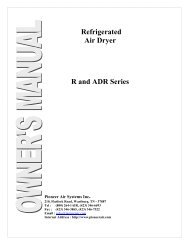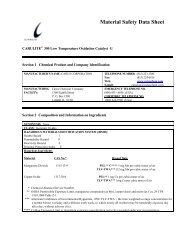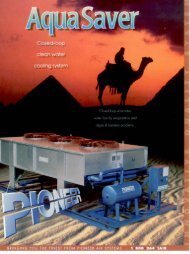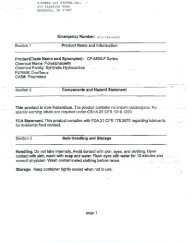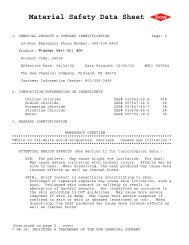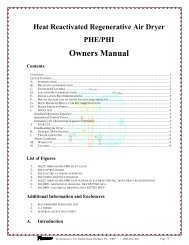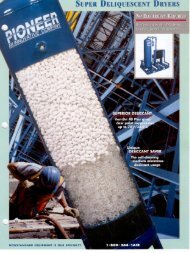XDT Manual - Pioneer Air Systems Engineering
XDT Manual - Pioneer Air Systems Engineering
XDT Manual - Pioneer Air Systems Engineering
You also want an ePaper? Increase the reach of your titles
YUMPU automatically turns print PDFs into web optimized ePapers that Google loves.
Capacitance (nF)<strong>XDT</strong> User’s <strong>Manual</strong> AppendicesAppendix F: Sensor/SpanCheck Theory of OperationThe Sensor is constructed as a capacitor whose dielectric consists of porous Aluminum Oxide aswell as the gas that has entered in the pores of the Aluminum Oxide. The plates (electrodes) ofthis capacitor are an aluminum substrate and a porous gold layer deposited on top of the AluminumOxide, the porous gold electrode allows transfer of gases into or out of the Aluminum Oxidepores.The capacitance due to the Aluminum Oxide is always constant, while the capacitance due to thegas varies according to the gas content and pressure. Since the dielectric constant of water isorders of magnitude larger than that of any gases being measured, the quantity of water vaporpresent in the pores changes the capacitance of the sensor to a much greater extent than any othersystem variable. For the same reason (the extremely large dielectric constant of the water molecule),any capacitance variations arising from the Aluminum Oxide, such as changes due to temperature,are insignificant in relation to the capacitance due to the water content. Thus the sensorcapacitance varies greatly in proportion to the water content in the surrounding gas. The sensor isdesigned such that the relationship of the quantity of water and the resultant capacitance has an"S" shaped curve. At the extremely dry end the curve is asymptotic to the capacitance due to theAluminum Oxide and the gas, while at the very wet end the curve is asymptotic to the capacitancedue to water molecules packed extremely tightly (saturated) in the pores of the Aluminum Oxide.This upper end is an excellent indication of the total pore volume; while the lower end of thecurve is an indication of the distance between, & area of the capacitor plates (electrodes), this isthe intrinsic capacitance of the sensor. Therefore knowing these two points, a sensor can be calibratedwith compensation for small manufacturing deviations.20016012080400Xentaur HTF Sensor: Dewpoint vs. Capacitance Response CurveSaturated Capacitance Asymtote of New SensorSaturated Capacitance Asymtote of Aged SensorNew SensorCurveAged Sensor CurveDry Capacitance Asymtote of New & Aged Sensor-80 -60 -40 -20 0 20Dewpoint Reference ˚CAs the sensor is used in real worldapplications, it is exposed to variouselements and stress; like any other sensorit may over time drift from calibration.However one must note that theintrinsic capacitance will not changewith use because it is based simply onthe dielectric constant of Al2O3 and thedistance between, & area of the plates(electrodes), thus the original factorymeasured values will always be valid.What may change is the pore volume,due to clogging with contaminants,residual oxidation, metal migration, etc.Thus to re-calibrate the sensor theinstrument needs only to “know” the capacitance at the wet end of the curve. As discussed previouslythe capacitance at the wet end approaches asymptotically a saturated pore capacitance,therefore if the sensor is saturated (the exact water content will not be important since the curve isasymptotic), then the instrument can measure the capacitance and re-calibrate the sensor. This isreferred to as SpanCheck.The advantages of this unique capability of Xentaur HTF sensorsand instruments are obvious in time and cost savings for re-calibration, as well as ease of sensorreplacement.45



